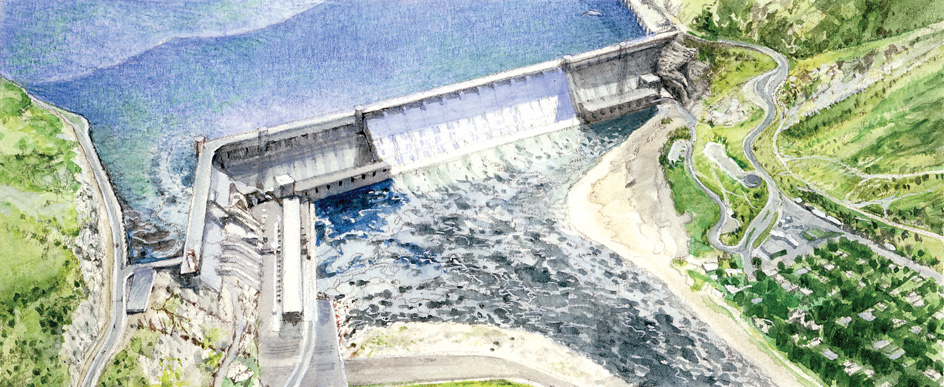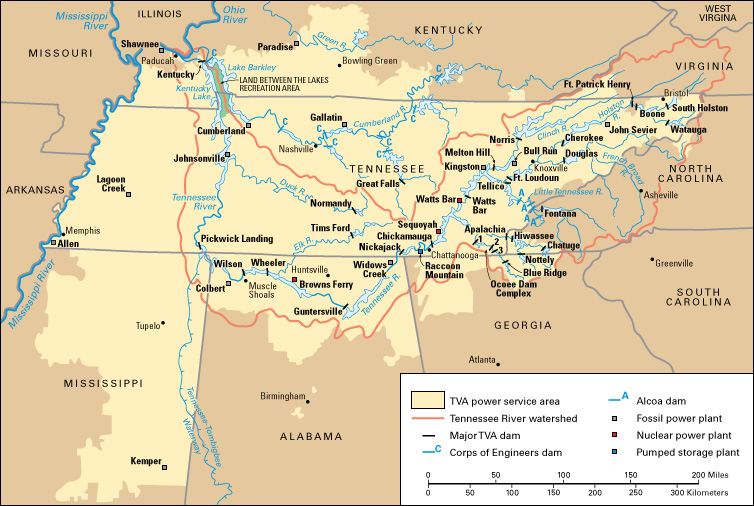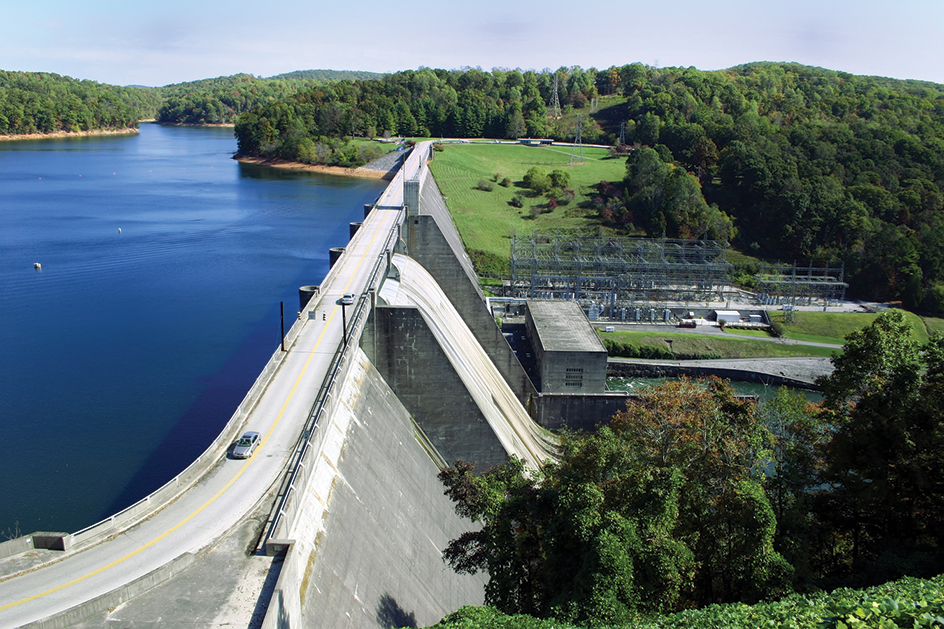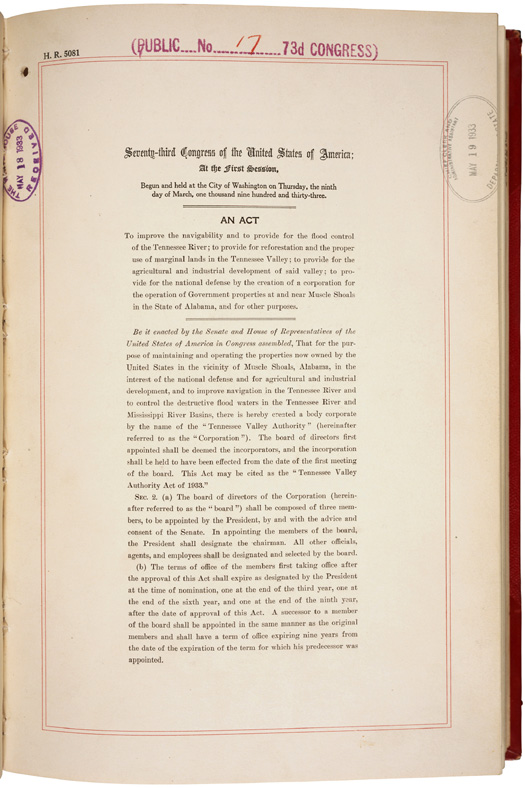Tennessee Valley Authority (TVA) is a federal corporation that works to develop the natural resources of the Tennessee Valley. Congress created TVA in 1933 and gave it the overall goal of conserving the resources of the valley region. Congress also directed TVA to speed the region’s economic development and, in case of war, to use the Tennessee Valley’s resources for national defense.

Beginning in colonial times, the valley’s forests had been cut down for lumber or to clear the land for farming and mining. The roots of trees and shrubs had held the soil in place and absorbed moisture. But when the forests were removed, the water ran off the land, carrying the topsoil with it. Farming became decreasingly productive, and flooding rivers caused loss of life and property.
Through the years, TVA has built dams to control floods, create electric power, and deepen rivers for shipping. TVA has planted new forests and preserved existing ones, and it has developed highly effective fertilizers. In addition, TVA has played an important role in agricultural and energy research and development and has helped create thousands of jobs in the region.
The valley.
The Tennessee Valley covers 40,910 square miles (105,956 square kilometers). The valley includes parts of Tennessee, Kentucky, Virginia, North Carolina, Georgia, Alabama, and Mississippi. The land varies from peaks 1 mile (1.6 kilometers) high in the Great Smoky Mountains to the low, muddy plains near the mouth of the Tennessee River. The valley has rich deposits of coal, copper, gravel, iron, limestone, manganese, marble, sand, and zinc.

Power from TVA reaches the homes and businesses of about 10 million people throughout 80,000 square miles (210,000 square kilometers) of the southeastern United States, many located outside the valley itself. TVA also directly sells power to dozens of large industries and federal agencies.
The dams.
Forty-nine dams on the Tennessee River and its branches work as a single system, making this one of the most effectively controlled waterways in the world. TVA built most of the dams. The agency directs the storage and release of water and the generation of power at four dams owned by Alcoa Inc. TVA also buys power from eight dams of the Cumberland River system, operated by the U.S. Army Corps of Engineers.

On the main stream of the Tennessee River, long dams were built, making a continuous chain of lakes from Paducah, Kentucky, to Knoxville, Tennessee. Each of these dams has a lock by which towboats and barges may be raised or lowered from one lake level to another. TVA dams on the Tennessee River itself are the Chickamauga, Fort Loudoun, Guntersville, Kentucky, Nickajack, Pickwick Landing, Watts Bar, Wheeler, and Wilson dams. Kentucky Dam, the largest, measures 8,422 feet (2,567 meters) long and 206 feet (63 meters) high. It creates Kentucky Lake, which is about 185 miles (298 kilometers) long.
On the branches of the Tennessee River, high dams were constructed to create great water reservoirs between the hills and mountains. The highest of these dams is Fontana Dam, 480 feet (146 meters) high, on the Little Tennessee River.
Electric power.
In 1933, the TVA region used only 16,000 kilowatt-hours of electric power a year. Today, the region uses about 160 billion kilowatt-hours each year. During TVA’s early years, dams generated much of its power. But as the demand for electric power increased, the agency had to find other power sources. Today, water power supplies about 12 percent of the electric power generated in the TVA system. The largest share of the TVA’s electric power is produced by nuclear power plants, followed by natural gas, coal, water, wind turbines, solar panels, and biomass. Biomass is material made by animals, plants, or other living things.
TVA has taken several steps to control environmental damage related to producing electric power. In the past, for example, much of the coal used by TVA to generate electric power came from strip mining. Strip mining, a method of surface mining, usually scars the landscape, pollutes rivers, and destroys valuable timber (see Mining (Surface mining methods)). TVA was criticized for buying coal from strip mines. As a result, TVA has since 1965 required operators of the strip mines supplying coal to its power plants to reclaim any damaged land. TVA manages one of the largest programs for controlling air pollution from coal-burning plants. TVA also uses 13 solar power sites to generate clean, renewable energy, and purchases such energy from a number of privately owned wind and solar power sites as well.
In addition, TVA provides practical assistance and low-interest loans to homes and businesses to encourage them to conserve energy and to install solar-energy devices. This program aims to help cut overall energy costs and reduce the need for new power plants.
TVA was designed to provide abundant power for the region at the lowest possible rates. Household users of TVA power pay among the lowest rates for power usage in the United States. About 160 local nonprofit electric power distributors furnish TVA power for consumers.
River shipping.
The Tennessee River provides more than 650 miles (1,046 kilometers) of waterway for boats to navigate. It connects with the inland waterway system. Today, barges on this system carry about 50 million tons (45 million metric tons) of freight yearly.
Flood control.
Most floods on the Tennessee River occur in late winter and early spring. TVA lowers the lakes in the region during fall and early winter to create space for the expected floodwaters. As the flood season passes in late spring, TVA allows the lakes to fill gradually to high levels for the summer.
Other activities.
For much of the 1900’s, TVA operated the National Fertilizer Development Center at Muscle Shoals, Alabama. Scientists and engineers at the center worked to develop fertilizers and improve methods of producing them. TVA’s fertilizer activities were phased out in the late 1900’s. Today, researchers at TVA’s Muscle Shoals facility develop technologies and techniques to increase power system efficiencies and reduce the impact of TVA operations on the environment. Major areas of research include air and water pollution prevention, biotechnology, and cleanup of contaminated sites. TVA offers its resource-management technologies and expertise to outside clients.
The lakes created by damming the Tennessee River and its branches provide many recreational opportunities. States, counties, cities, and private organizations have developed many parks and other facilities. TVA itself developed the huge Land Between the Lakes recreational area between Kentucky Lake and Lake Barkley in Kentucky and Tennessee.
History.
Congress established the Tennessee Valley Authority after about 15 years of debate on how to use the government’s two nitrate plants and Wilson Dam at Muscle Shoals. These projects, built under the National Defense Act of 1916, had not been finished in time for use during World War I (1914-1918). The TVA Act transferred them from the War Department to TVA.

The new corporation represented a great change in national policy. Responsibility for various projects in the Tennessee Valley had been divided among the Departments of Agriculture, the Army, and the Interior. The TVA Act recognized that all conservation problems were related. It gave one agency the responsibility of improving all types of conservation and development of resources.
The creation of TVA became a highly controversial issue and remained so for many years. Private power companies strongly opposed government production of electric power. State and local agencies in the Tennessee Valley feared that TVA would take over their functions. Political opponents of President Franklin D. Roosevelt’s New Deal—a program that sought to pull the United States out of the Great Depression during the 1930’s—used the issue of the TVA’s creation to attack him.
TVA pays no federal income taxes, but it pays hundreds of millions of dollars in revenue to state and local governments in place of taxes. A board of nine members directs TVA. The president of the United States appoints them to five-year terms with the consent of the Senate, and they report to the president.
